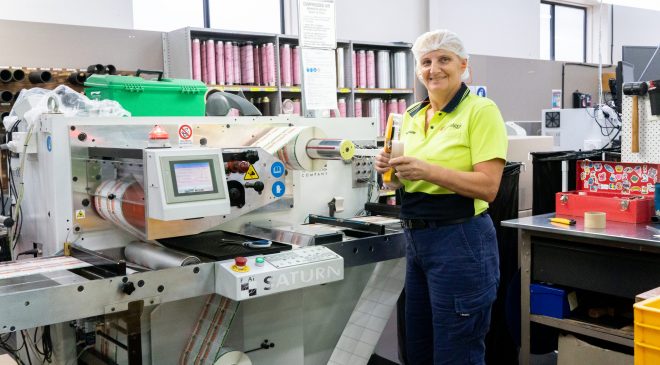
Winson Group proved power of cloud through rapid response to pandemic.
When things began to not feel right during an 2019 trip to China, Alan Webster general manager Information Technology at Winson Group decided to act immediately and ordered new mobile devices as a “just-in-case”.
Within days of the just-in-case came and Webster was had to hand out the new devices to executives and managers, allowing them to start working from home the minute that COVID-related restrictions came into force.
It was a typically canny move from Webster, who is general manager of information technology at the Winson Group.
The packaging, labelling, and marking business that works with major brands across Australia to package and label their products, that makes the paints used to mark out sporting grounds as well as the bubble wrap that protects even the most fragile products.
Operating under the Signet and Insignia brands the private family-owned business has warehousing, manufacturing and offices stretching across Australia and employs nearly 300 people.
By the time Webster hopped on a plane for his well-earned break back in 2019 he had already begun a major digital modernisation at Winson, replacing a patchwork quilt of ad hoc applications with an integrated, Microsoft Azure-based platform, leveraging both Dynamics 365 and Microsoft 365.
That meant that when Webster returned to work in 2020 and Winson’s managers headed home with their presciently purchased laptops, everyone was able to immediately access the cloud-based applications and get to work.
It provided clear evidence of the resilience and agility that the new digital platform could deliver – and confirmed to Webster that his strategy was the right one.
Agility and transparency
Aware that the business needed to be agile in order to respond to changing customer needs and shifting supply chains, also that Winson’s decision makers needed access to accurate and timely data, Webster developed his transformation blueprint with Microsoft cloud at the heart.
It was designed to deliver the insights the business needed to ensure operational efficiency and excellent customer service – but also promised the scalability and security that would reduce risk.
Working with Microsoft partner DXC, Webster first deployed Dynamics 365 Customer Engagement as well as Office 365 and started to transition other applications off its own servers and into Microsoft Azure.
By the time Webster got back from his Japanese holiday he was ready to build on those established cloud foundations and accelerate his other plans. Thanks to the pressures of the pandemic that included rolling out Teams to the entire organisation in just one week.
Teams allowed managers to connect to staff wherever they were working with weekly video updates ensuring people were kept in the loop about business performance and how Winson was responding to the pandemic.
Webster also rolled out Teams Calling to ensure staff – including contact centre personnel – could connect and communicate anywhere, anytime.
“Over the course of three to four months we rolled out Teams Calling and took the old VOIP system out. That’s allowed us to dispense with a whole load of costs and landlines,” he said.
According to Webster, moving to Azure and deploying Teams Calling has reined in operating costs by more than 10 per cent while delivering improved capability and scalability.
Support and service
On the Insignia side of the business, which handles labels and print application, Webster has rolled out Dynamics 365 Field Service to support service technicians as they attend customers providing either installation or service.
Using Dynamics 365 queues, which may arise from a customer email or call to the contact centre, a field service technician is alerted when a customer needs help. A mobile phone app powered by Microsoft Field Service shows the technician their jobs for the day, ordered in priority and according to geography.
That information is also displayed in aggregate on a service schedule board in Insignia’s offices which makes it clear where technicians are at any point in time, and their estimated time of arrival at a subsequent job.
The Field Service App also lets technicians provide customers with an estimate regarding the cost of a job, which can then be approved by the customer before the work takes place.
“Then after the job is closed, we actually bring that back through integration for invoicing and then closing out the financial transactional side of the job. It’s light years different to what it was,” Wilson noted. “There was a lot of distance between the customer service technician and then the actual invoice being generated.”
Besides accelerating the process, it’s streamlined technicians’ workday as they can now input everything into the app, which then automatically generates a workflow.
Improved access to data is also streamlining inventory management says Webster. “If we know we’ve got 10 jobs in six months’ time and there’s a lead time on components of three months, then three months out we will be raising part requests on our suppliers.”
That’s been particularly important through the pandemic when there have been supply chain constraints. Having an early warning of what parts or supplies might be needed well in advance allowed insignia’s procurement team to alert its usual suppliers in good time or find alternate sources so that the business and its customers would not be constrained.
Winson has also used Power Apps to build a shop floor data capture system for Insignia that provides a window on operations as well as creating the opportunity to track operational metrics in real time. The App has been deployed onto tablets on the shop floor and provides real time data from Dynamics Business Central and allows the operators to enter job information including down time if required.
Data is gold
All of this data can then be surfaced to managers through Power BI which is also used for analysis and reporting with the Azure based data ensuring access to a single source of truth across the business.
To ensure corporate data is properly secured has been a priority at the company which is now also using Microsoft Sentinel.
The Field Service App also lets technicians provide customers with an estimate regarding the cost of a job, which can then be approved by the customer before the work takes place.
“Then after the job is closed, we actually bring that back through integration for invoicing and then closing out the financial transactional side of the job. It’s light years different to what it was,” said Wilson. “There was a lot of distance between the customer service technician and then the actual invoice being generated.”
Besides accelerating the process, it’s streamlined technicians’ workday as they can now input everything into the app, which then automatically generates a workflow.
Improved access to data is also streamlining inventory management said Webster.
“If we know we’ve got 10 jobs in six months’ time and there’s a lead time on components of three months, then three months out we will be raising part requests on our suppliers.”
That’s been particularly important through the pandemic when there have been supply chain constraints. Having an early warning of what parts or supplies might be needed well in advance allowed insignia’s procurement team to alert its usual suppliers in good time or find alternate sources so that the business and its customers would not be constrained.
Winson has also used Power Apps to build a shop floor data capture system for Insignia that provides a window on operations as well as creating the opportunity to track operational metrics in real time. The App has been deployed onto tablets on the shop floor and provides real time data from Dynamics Business Central and allows the operators to enter job information including down time if required.




